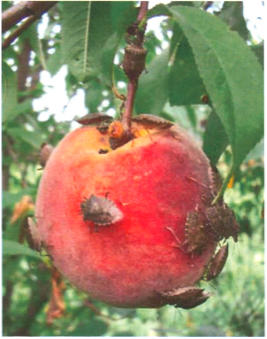
Photo: USDA
By EMMA OGUTU
LANSING – The name of the new invader is enough to make people laugh, but its potential peril is serious enough to make fruit growers weep.
The brown marmorated stink bug, which is notorious for wiping out horticultural crops, has been discovered in Southwest and central Michigan.
The stink bug, known for its destructive feeding habits, could wreak havoc on Berrien County’s fruit, vegetable and ornamental plant industries if immediate action is not taken, according to Larry Olsen. He is the co-director of the U.S. Department of Agriculture (USDA) North Central region Integrated Pest Management Center and an entomologist at Michigan State University.
A research student from MSU collected the stink bug, which gets its name from the smell it emits when crushed, in Berrien County. An MSU Extension educator discovered another in Eaton County.
Entomologists from the USDA have since verified both samples as an invader species similar to a common species native to Michigan.
“There is a huge potential for significant crop damage and loss in Berrien County and other parts of the state as its population rises,” Olsen said. “This bug infests strawberries, apples, peaches, cherries, vegetables and ornamental plants, all produced in large quantities in this county.”
Berrien County ranks second in acres of fruit and berry and third in annual revenue of more than $36 million, according to the Michigan Department of Agriculture.
Olsen said that eastern U.S., where the stink bug was first spotted more than a decade ago, has experienced great damage to its fruit industry.
“Since it’s just newly discovered in Michigan, we can only estimate the kind of damage it can cause by looking at its impact in other regions, but it can be devastating,” he said.
In 2010, growers in Pennsylvania lost an estimated 40 to 50 percent of their peach crop to the stink bug, according to Penn State University’s College of Agricultural Sciences. While damaged fruits sold for processing may sell for $7 to $10 a bushel, undamaged ones could garner up to $20 to $60 on the fresh fruit market.
The winged invader, which can attack an estimated 300 species of plants, also destroys apples, peaches, blackberries, sweet corn, field corn and soybeans, according to Penn State.
Bill Shane, who is responsible for tree fruit research at the MSU Southwest Michigan Research and Extension Center in Berrien County, said that there were cases where entire peach crops were damaged in the East.
He said that the stink bug is new to the state and that his center is trying to learn from other states how to head them off before they get to orchards.
Shane is on a team of researchers and Extension specialists collaborating with USDA entomologists and experts from universities in the affected states.
According to Sen. Howard Walker, R-Traverse City, research needs to be done before the state can take action.
“We just need to continue funding the state’s arms of research, including extension services at MSU,” he said.
Shane said that the stink bug nests and multiplies on field crops such as soybeans and corn and comes out in swarms once the crops mature and dry down, heading towards orchards and other plants.
“So we’ll be trying to see how we can use a chemical barrier on the outside edges of the orchards and vineyards we’re trying to protect,” Shane said.
One strategy is to spray the beetles while they are in the grass and weeds along their travel route to reduce the number reaching the orchards.
However, the waxy, hard-shelled bug is well-adapted to survive harsh chemicals.
“Its outer skin is repellent to water so that it doesn’t readily absorb chemicals,” Shane said. “The bugs are also relatively large and require a bigger chemical dose to destroy.”
He said that the bug uses a thin, sharp-pointed proboscis to pierce and suck out nutrients inside plant tissue, bypassing insecticide on the plant surface.
But the pest’s body features aren’t its only survival mechanisms.
“Certainly any pest that moves in such vast numbers over large areas and has a wide host range is suited for getting established quickly and is harder to control,” Shane said.
The bug is also a prolific breeder, producing up to two generations each year in the region, Shane said. In other parts of the world, it’s known to reproduce up to six times a year. Each female can lay up to 400 eggs per generation.
Researchers are looking at alternative ways to manage the pest.
Olsen said that his team is searching for the stink bug’s natural enemies to import into infested regions to keep the population low.
But a natural enemy must be specific to the species, according to Olsen.
“It has to be one that feeds or infests only on the pest and not on other animal, plant or beneficial insect species, and this takes a lot of research just to be sure,” he said.
Though the population of the marmorated stink bug is still relatively low in Michigan, according to Olsen, reports from the USDA indicate that even small populations can cause serious economic damage if left unchecked.
“We still need to do a large survey to measure its population and spread,” Olsen said. “Then we also need a second survey to measure its economic impact in the region.”